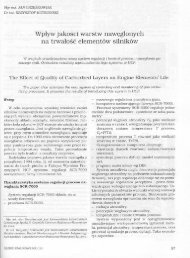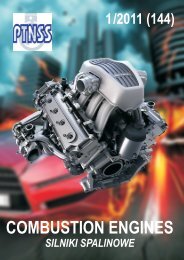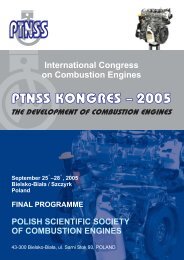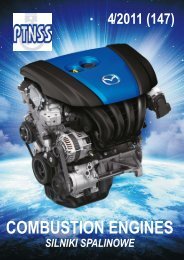Create successful ePaper yourself
Turn your PDF publications into a flip-book with our unique Google optimized e-Paper software.
Badania możliwości poprawy równomierności odsysania pyłu z osadnika multicyklonu filtru powietrza...<br />
the values of the extracted streams Q SC<br />
occurred as compared to the situation<br />
before the introduction of the channels.<br />
A significant variation occurred<br />
between the values of the streams<br />
extracted from the cyclones within a<br />
single extraction channel at the same<br />
value of the main extraction stream<br />
Q SS<br />
. The greatest differences (more<br />
than 30%) occurred in the cyclones<br />
within channel 1. For the rest of the<br />
channels (2, 3, 4) the differences<br />
were on the level of 7%. The reasons<br />
for such a large difference among the<br />
streams Q SC<br />
of the first and the third<br />
cyclones are the design of channel 1.<br />
Its height as a result of the positioning<br />
of the partition parallel to the skewed<br />
bottom of the dust collector decreases<br />
and in the final part, covering the outlet<br />
of the third cyclone, reaches a value<br />
of 1 mm. The same may be the reason<br />
for a small value of the stream Q SC<br />
extracted<br />
from cyclone VI of channel 2. A lack of the chamber<br />
in channel 1 resulted in a very strong damping of the outflow<br />
of the streams from the final cyclones of this channel.<br />
By positioning of the partition of channel 1 parallel<br />
lengthwise at a distance h 1B<br />
to the upper plate of the dust<br />
collector (variant B) a chamber of the height of h 1B<br />
= 8.5<br />
mm was created (Fig. 8).<br />
The outflow of the streams extracted from cyclones I,<br />
II and III is realized to a space of greater volume, which<br />
reduces the damping of the outflow of the streams from<br />
these cyclones. The partitions of the outstanding channels<br />
and the bottom of the dust collector were positioned parallel<br />
to the partition of the first channel maintaining the previous<br />
distance between them. As predicted, a decrease in the difference<br />
between the values of the streams extracted from the<br />
cyclones in channel 1 occurred. The changes in the values<br />
Q SC<br />
occurring in the outstanding channels are insignificant<br />
(Fig. 9).<br />
At the same value of the extraction stream Q SS<br />
, there is<br />
still a great difference between the values of the streams<br />
Fig. 7. The values of the streams Q SC<br />
extracted from the individual cyclones of the section of the<br />
BWP-1 multicyclone dust collector with the collector chamber partitioned into extraction channels –<br />
variant A and before partitioning<br />
Rys. 7. Wartości strumieni odsysanych Q SC<br />
z pojedynczych cyklonów segmentu osadnika pyłu multicyklonu<br />
BWP-1 z komorą osadnika podzieloną na kanały odsysania – wariant A i przed podziałem<br />
Fig. 8. Schematics of the BWP-1 multicyclone dust collector section – variant B: 1 – cyclone, 2 – channel partitions,<br />
3 – outlet manifold, 4 – bottom of the dust collector<br />
Rys. 8. Schemat osadnika pyłu segmentu multicyklonu BWP-1 – wariant B: 1 – cyklon, 2 – przegrody kanałów,<br />
3 – kolektor wylotowy, 4 – dno osadnika<br />
klonach (kanały nr 3 i nr 4) nastąpił znaczny wzrost wartości<br />
strumieni odsysanych Q SC<br />
, w porównaniu z sytuacją przed<br />
wprowadzeniem kanałów. Wystąpiło duże zróżnicowanie,<br />
przy tej samej wartości głównego strumienia odsysania Q SS<br />
,<br />
pomiędzy wartościami strumieni odsysanych z cyklonów w<br />
obrębie jednego kanału odsysającego. Największe różnice<br />
(ponad 30%) wystąpiły w cyklonach objętych kanałem nr 1.<br />
Dla pozostałych kanałów nr 2, 3, 4 różnice te kształtowały się<br />
na poziomie 7%. Przyczyny tak dużej różnicy między strumieniami<br />
Q SC<br />
pierwszego i trzeciego cyklonu należy szukać<br />
w konstrukcji kanału nr 1. Jego wysokość, w wyniku równoległego<br />
ustawienia przegrody do skośnego dna osadnika,<br />
zmniejsza się i w końcowym odcinku, obejmującym wylot<br />
trzeciego cyklonu, ma wartość 1 mm. Ta sama przyczyna<br />
może być powodem małej wartości strumienia odsysania<br />
Q SC<br />
z cyklonu nr VI kanału nr 2. Brak komory w kanale nr<br />
1 spowodował bardzo silne tłumienie wypływu strumieni<br />
powietrza z ostatnich cyklonów tego kanału.<br />
Ustawiając przegrodę kanału nr 1 równolegle na całej<br />
jego długości w odległości h 1B<br />
do górnej płyty osadnika<br />
pyłu (wariant B), utworzono<br />
komorę o wysokości h 1B<br />
=<br />
= 8,5 mm (rys. 8).<br />
Wypływ strumieni odsysania<br />
z cyklonów nr I, II i<br />
III odbywa się do przestrzeni<br />
o większej objętości, co<br />
zmniejsza tłumienie wypływu<br />
strumieni z tych cyklonów.<br />
Przegrody pozostałych<br />
kanałów oraz dno osadnika<br />
wykonano równolegle do<br />
przegrody pierwszego kanału,<br />
zachowując poprzednie<br />
odległości między nimi.<br />
40 <strong>COMBUSTION</strong> <strong>ENGINES</strong>, No. 4/2012 (151)












